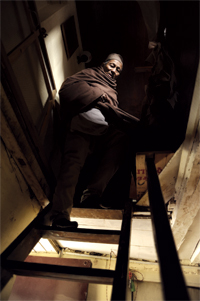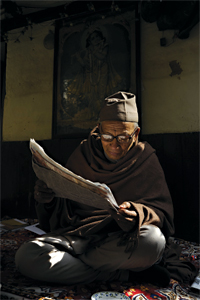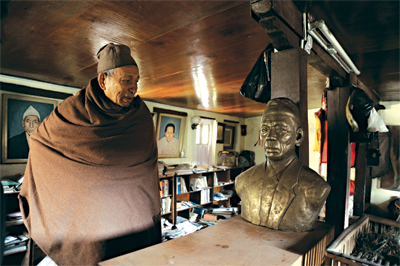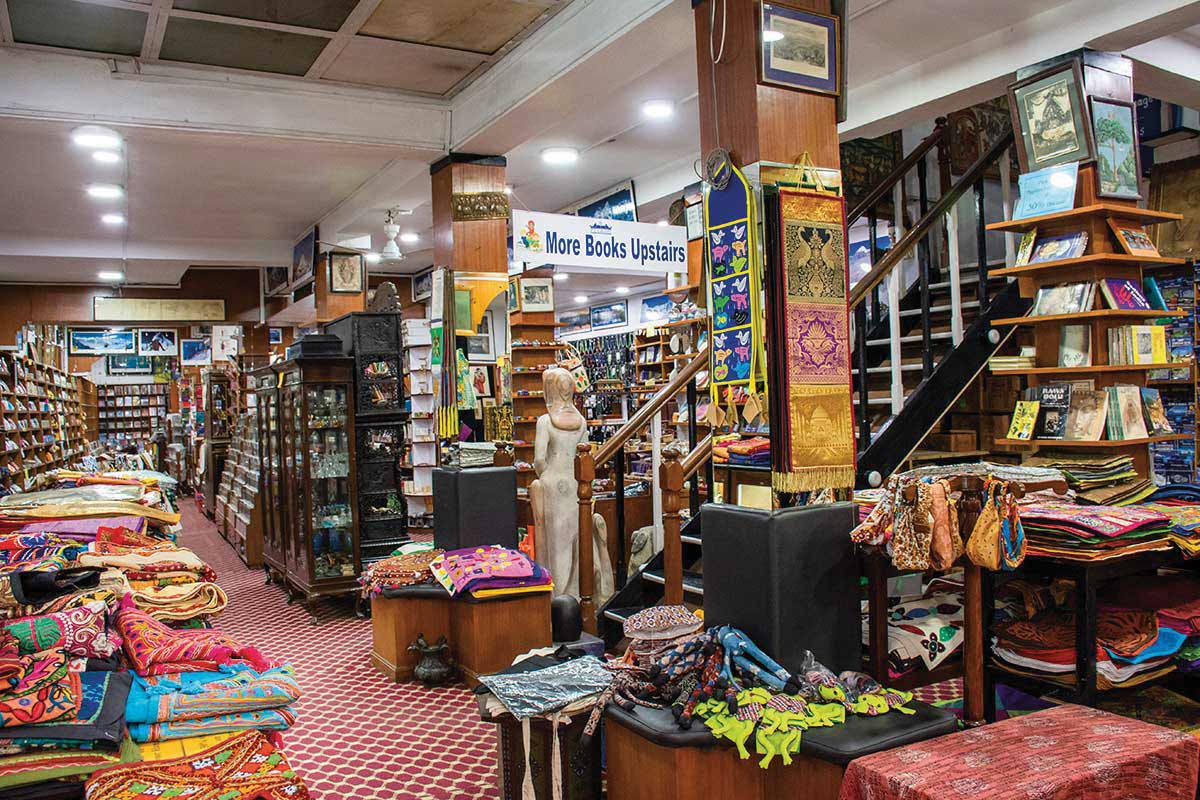Satya Mohan Joshi is not any ordinary grandfather; he is a man who has garnered respect as to make any national leader envious. Satya Mohan however, is certainly no politician. So, what has he done that makes him so special a person?
Talking to him is a most comforting experience. He instantly brings to mind fond memories of one’s grandfather. However, Satya Mohan Joshi is not any ordinary grandfather; he is a man who has garnered respect as to make any national leader envious. Satya Mohan however, is certainly no politician. So, what has he done that makes him so special a person?
Wondering about the answer to this, I went to meet him at his home in Bakhuwa Bahal, Patan. Walking in, I saw him sitting on a small carpet on the porch of an old two-storied house, in conversation with a journalist. I listened in on their conversation, this being as good an opportunity as any to get an insight into my question.
 Living upto his name
Living upto his name
Satya Mohan was telling the reporter about the intricacies of Nepali folk songs. Flipping through a notebook as he talked, he would occasionally sing out a verse or two before explaining its meaning and a little historical trivia. His voice was strong and had a pleasing tone. He appeared healthy and surprisingly sturdy for a 91 year-old man. Highly regarded for his intellect, wisdom and integrity, if ever an example was needed of someone living upto his name, then one would not have to look further any further than Satya Mohan (Nepali for truth-charm).
Charming and honest to a fault, the man is wise, intellectual and unassuming. An expert on Nepali culture, including on language, history, folklore, folk songs, art and life style. Later that day, he was to attend a meeting at the Nepal Tourism Board to give his opinion on the designing of silver coins to commemorate Nepal Tourism Year 2011. He is also on the design committee of the Nepal Rastra Bank for designing new coins. However, he hardly goes out anymore; surprising considering how just a year ago, his wife Radha Devi had disclosed to me that he is hardly at home. On that day, he had left for Kirtipur in the early hours of the morning.
 Highlight of an eventful life
Highlight of an eventful life
Kirtipur holds special significance in Satya Mohan’s life. It is where the Arniko White Dagoba Gallery is located, of which he is the Founder-Curator. The gallery is situated within the Nepal Bhasa Academy building, the premier academy for preservation and upliftment of the Newar language (Nepal Bhasa). Satya Mohan is a Founder-member of the acadamy. The academy and the museum are the high points of his long and eventful life. About the academy, he discloses, “We began with 500 rupees as seed money.” So high is the pedestal on which he stands in terms of honest endeavors that soon contributions began pouring in, in hundreds of thousands of rupees. Expectedly, most such contributions came from rich Newar businesspersons.
As for the museum, the collection was a result of his stay in China for five years, during which time he collected as much as he could, especially items pertaining to Arniko, the legendary 13th century architect/sculptor/artist who earned fame and fortune in China. In time, the collection became so huge that he decided to make it public by setting up an exclusive gallery of the master. By some accounts, the museum has not been very successful at attracting that many visitors. This is what disturbs Satya Mohan, that people do not appreciate Arniko’s contribution to Nepali art and architecture as much as they should. This is what the 91-year old has been trying to amend. Arniko is a legend who deserves all the high honors that can be bestowed upon him by a nation, but it is equally true that Satya Mohan himself is no less of an inspirational figure today. A force that forces all to question themselves: “If a man who is above 90 can be still so motivated and enthusiastic, can there be any excuse for others not to be as driven in the pursuit of their dreams?”
 A legend in his own time
A legend in his own time
A living legend is what Satya Mohan Joshi is. His wife, Radha Devi, 86, seems to be perfectly synched with Satya Mohan’s lifestyle and theirs’ seems to be a perfect coupling of the ying and the yang. The prolific writer tells me that religious occasions are a constant event in his home and that he has arranged for a spiritual discourse at his house every Monday for two hours. “It is attended by about 20 women; it’s good for my wife,” he says.
Later, he leads me up a narrow wooden stairway to a room with a mud plastered floor and a low ceiling. Lining the wall are shelves full of books, manuscripts and other papers. Many more items lie scattered on the ground and on tables around the room. The thought that a man of his caliber could do well with a capable secretary to keep his life and his work organized passes through my mind. Such would have been the case if he had been in a more developed country. Perhaps such an arrangement would have made him more productive. However, one has to make do with things as they are and even with these limitations, Satya Mohan has been able to achieve much more than most people with a similar bent of mind and talent.
One of his greatest contributions is perhaps the production of 14 dictionaries, one of the Nepal Bhasa, and thirteen in other regional languages of the country. In 1970, he made a trip to the far western region of Karnali as part of a five-member team to research the origins of Nepali Bhasa. Their five-month long stay resulted in five books: one titled, ‘The Historical Aspects of Karnali People Folklore’ by N. Rimal, another on the region’s geography by Sthir Jung B. Singh, one by the linguist Chudamani Bandhu, one on its anthropology by Bihari Krishna Shrestha and one on the history of the area by himself.
Besides his accomplishments in the academic world, Satya Mohan is also renowned as a playwright and knows folksongs like nobody else. Satya Mohan Joshi became the first director of the Archeological and Cultural Department in 1959, and established the Rastriya Naachghar (National Theatre) in Kathmandu, the Archeological Garden in Patan, the Archeological Museum in Taulihawa and the National Painting Museum in Bhaktapur. He resigned from service in 1960 and went to China where he stayed for almost five years teaching Nepali at the Peking Broadcasting Institute. He says that folk culture is his primary subject of study and that his career started by collecting folk songs. He visited many villages to do so and published his collection as ‘Hamro Lok Sanskriti’ (Our Folk Culture) in 1956, which was awarded the Madan Puraskar, the highest literary honor in Nepal.
Similarly, two other works, namely, ‘Nepali Rastriya Mudra’ (The Coinage of Nepal) published in 1957 and ‘Karnali Lok Sanskriti’ (Folk culture of Karnali) published in 1971 also went on to win the prestigious award. He has also been recipient of the “Shrestha Sirpa” for his outstanding book ‘Jayaprakash’- an epic in Nepal Bhasa (Newari). In addition to these, Satya Mohan has many other publications to his credit including, ‘Legends of Lalitpur’ and ‘Kalakar Arniko’. The renowned litterateur is the Chancellor of the Nepal Bhasa Acadmy and was a member of the Royal Nepal Academy from 1969 to 1978. He was its Member Secretary when he left.
Clearly, Satya Mohan stands a notch above the rest. As if to provide justification to such numerous accolades, a bronze bust of him sits on a table in his room, a present from a man named Surya Bahadur Shrestha. Now, how many men or women can claim to have such symbols of immortality made in their lifetime? How many can lay claim to such high respect?










